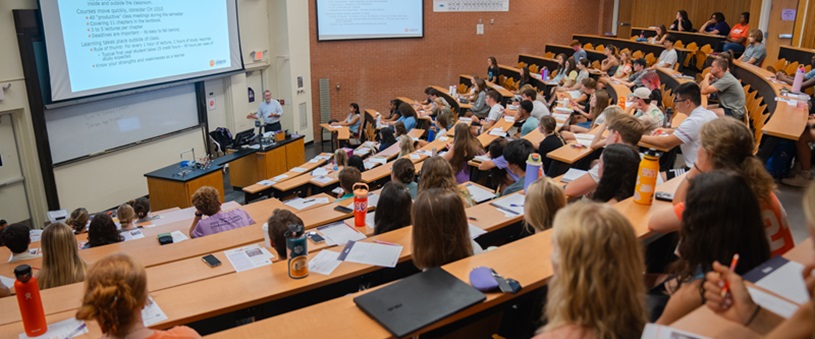Documenting Teaching Effectiveness
This page provides information for faculty members, Department Chairs and School Directors so they can decide what additional methodologies will be used to evaluate teaching.
There is ample evidence documenting variables affecting student evaluations of teaching. The differences in student perception can even be correlated to facial structure, and seem to apply differently for different professors. Aiming to minimize these effects, recent changes in the Faculty Manual were performed under the guiding principle that a more diverse approach to evaluate teaching effectiveness will minimize the effect of such biases.
Prior to adopting specific methodologies for measuring effectiveness, we recommend that:
- The faculty member has an open dialogue with the corresponding committees and discusses the methodology, the data to be collected and includes an objective assessment plan prior to the implementation.
- The parties involved carefully select courses (levels and sections) that accurately reflect the faculty member’s abilities and expertise.
- The faculty member takes advantage of the resources and protocols provided by OTEI, which will ensure consistency across evaluations.
- A plan is established well in advance, so the faculty member has the opportunity to address any shortcomings in subsequent semesters and show (using the same methodology) the improvements.
- Evaluators receive training on the methodologies to be applied before embarking in the evaluation process.
- Faculty consult with the guidelines provided by the College of Agriculture, Forestry and Life Sciences (CAFLS). The site includes a compilation of discipline-specific resources and examples to make it easier for faculty to identify and provide appropriate evidence of teaching effectiveness.

How to Document Teaching Effectiveness
The 2024 Faculty Manual specifically states that teaching must include feedback from instruction and course evaluation forms completed by students, where no single quantifier from these forms may substitute for a wide-ranging review of the responses (Chapter V, Section E.2.e.), and that requires the inclusion of at least two of the following metrics (Faculty Manual, Chapter VI, F.2.k.i):
-
1. Evidence-based measurements of student learning that meet defined student learning outcomes
- Consider providing specific learning outcomes in the syllabus of the course, which will be then attached to the corresponding results.
- Consider specifically aligning test questions with learning outcomes and providing a rationale for the interpretation of the results.
- Examples include:
- Using standardized tests (or tests with questions agreed upon with a teaching committee) to assess the preparation of the students for a course vs. the knowledge gained after the course
- Analysis of student independent work (writing assignments, presentations, essay questions, etc.)
- Student engagement (including trends in learning) evaluated in class via interactive response systems (i.e. iClicker)
- Grades
- Additional resources
-
2. Evaluation of course materials, learning objectives and examinations
- Examples include:
- Teaching portfolios: including syllabus, lecture notes, tests, grade distribution, comments from students and efforts to improve student learning
- Access to Clemson Canvas pages (or printouts of the sites)
- Examples include:
-
3. In-class visitation by peer evaluators, external visitors and/or administrators
- Invited seminar speakers can provide an external opinion on teaching without imposing additional financial burdens on the department.
- Clemson University has a panel of certified evaluators who can provide objective opinions about the pedagogical approaches used in the course. This evaluation could be complemented by peers from the same department, who will focus their comments on the content delivered.
- Additional Resources:
- OTEI's Peer Observation of Teaching Course - This course provides an overview of teaching observations in higher education today, sample documentation and a suggested approach and schedule.
-
4. A statement by the faculty member describing their methods and/or a teaching philosophy
- While there are some challenges associated with the objective evaluation of these statements, this methodology can provide reasoning for the selection of pedagogical approaches and content for a course.
- Please visit the Teaching Philosophies page to obtain more information.
-
5. Exit interviews or surveys with current graduates and/or alumni
- While exit interviews are common practice after employee separation (especially in industry), a few programs have extended this practice to evaluate teaching in specific courses.
- Although the literature available related to this practice is quite limited, the involvement of Department Chairs / School Directors is essential to improve the reliability of the information collected.
-
6. A statement by the faculty member of methods or philosophy that also describes and documents how feedback from student rating of course experiences or evaluation instruments above were used to improve teaching
- Please visit the Teaching Philosophies page to obtain more information.
Additional Metrics
Additional metrics to support the evaluation of teaching activities may also be acceptable. Faculty are strongly encouraged to develop the corresponding assessment plans in consultation with their academic units. The combination of sources should strike a balance between the needs of faculty members and the need for an objective evaluation. Examples of these metrics include, but are not limited to:
-
Receiving peer-evaluation training and participating in peer-review evaluation of other faculty members across the college and university
- As a collaboration with OTEI, our Office has developed a short training program so faculty can learn the most basic elements of this process.
- If you are interested, please visit the page describing Peer Observation of Teaching.
-
Mentoring other faculty members in pedagogy, course organization, student engagement and other relevant teaching approaches
- Although there are multiple mentoring models available (article 1, article 2, article 3), it is absolutely clear that mentoring programs have a positive effect on both professional development and personal well-being.
- Thus, this option is intended to give "teaching credit" to those who invest their time in the development of others. Activities could be directly related to a common course or directed to more general teaching approaches.
- Faculty interested in this option should consider describing the mentoring style offered, the number of mentees, the workload expectations and the expected credit.
- Additional resources:
- Mentoring Portal -Indiana University
- Mentorship and Role Modeling - University of Northern Colorado
- Institutional Approaches to Mentoring Faculty Colleagues (article)
-
Teaching scholarship, activities, and awards
- There are multiple activities that could account as part of teaching scholarship, but most often these are linked to structured research activities related to teaching (teaching publications, conferences, etc.).
- Faculty may inquire about the possibility of including other teaching activities (participation in teaching workshops, development of teaching materials, preparation of a new course, etc.), which may be counted towards this category.
- Exceptional teaching promotes student learning of any discipline and includes all aspects of instruction. These recognitions not only highlight the contributions of the faculty member but also validate the value of the tasks performed.
-
Learning outcome measures, formative assessments, or evidence of inclusion of research-supported teaching and active learning methods
- The overall goal of these approaches is to improve instruction. This assessment can be done formally (official report disclosed) or informally (feedback provided to the faculty member only), and there are multiple ways and metrics to implement these approaches.
- Perhaps the simplest way is by performing self-assessments of course materials (syllabus, Canvas course readiness, test grade analysis, identification of unclear concepts, etc.).
- Additional resources:
- Formative Assessment of Teaching - University of Pittsburgh
- Formative and Summative Assessments - Yale
-
Performing substantial changes in a course to improve accessibility
- This can be accomplished in multiple ways, including addressing the issues identified by a manual/automated accessibility audit.
-
Additional evidence-based teaching activities
- Examples include:
- Student performance in later sequential courses
- Inclusion of activities and/or modules that address previous feedback from students
- Development of new courses
- Flipped courses
- Inclusion of course modules/activities that support the goals of Clemson Elevate
- Integrating activities aimed at highlighting inclusive excellence
- Global engagement: consider inviting a guest lecture from a colleague in a different country, presenting a topic that is especially important to other regions/countries or simply encouraging students to include global ideas in their presentations. Clemson also offers support via the Global Learning Institute for Faculty.
- Service and/or experiential learning
- Community engagement
- Communities of practice
- Examples include:
Please note that collectively, all these approaches are often considered components of a teaching portfolio. They give faculty the opportunity to provide not only the core information related to their teaching assessment approaches but also the context to interpret such information. Please visit Teaching Evaluations to obtain more specific information about each one of these methodologies.
Also, please note that besides providing much broader options for faculty to measure the teaching and learning impact of their courses, the new strategy also aims to minimize the potential biases introduced when a single assessment method is used, as current research indicates that it is unlikely that multiple metrics will be biased in the same way. Furthermore, and regardless of the amount of literature supporting the importance of using multiple methods when assessing teaching performance, it is critical to highlight the role of faculty engagement during the transition period.

Using Student Feedback
Check out this summary from Becky Tugman, extracted from one of the workshops we co-organized with OTEI.
View student feedback summaryFrequently Asked Questions
This is a collection of questions received from faculty, Department Chairs / School Directors, and Chairs of TPR Committees.
-
How do I determine what is the best methodology to evaluate my courses?
- That decision should be made through close consultation between the faculty member and the Department Chair, School Director, or designee.
- Among other factors, it is recommended to consider:
- How many times that faculty member has taught that class.
- If the faculty member will have the opportunity to teach that class again and address any concerns.
- Additional resources:
-
What happens if a faculty member agrees on a teaching evaluation approach and now faces a change in leadership?
- As a general rule, it is recommended to document the selected strategies, along with the corresponding assessment approaches and expected goals.
-
How much effort should a faculty member dedicate to teaching?
- Teaching is an integral part of our University and a central theme of our Strategic Plan, Clemson Elevate.
- The time/effort allocation each faculty invests in teaching activities is quite diverse and can vary from one department to another.
- It is strongly recommended that faculty discuss this topic with the corresponding Department Chair, School Director, or designee.
- In addition, most faculty members at Clemson also receive support from a mentor who can provide guidance on effort allocations in relation to their career goals. Moreover, Clemson offers support via the Office of Teaching Effectiveness and Innovation, which can provide expertise and access to specific resources.
